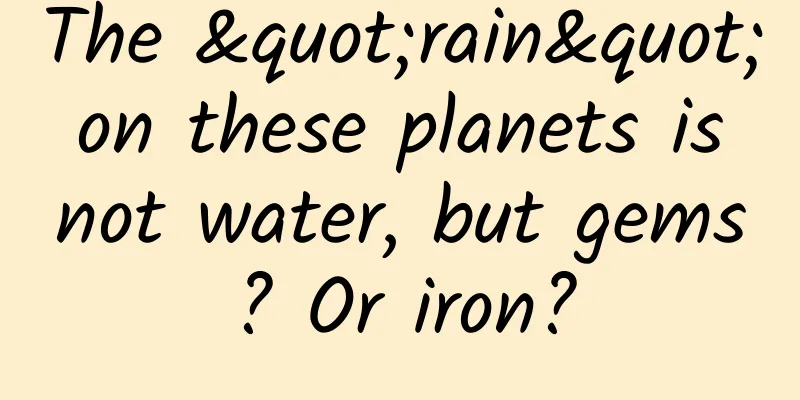The "rain" on these planets is not water, but gems? Or iron?

|
Plants and animals on Earth cannot live without rain, but if you think that rain is only unique to Earth, you are wrong. Scientists have discovered that it rains on many planets in the universe, but the rain is usually not water. If it doesn't rain water, what else can it rain? Rain comes from clouds. Clouds on Earth are made of water vapor, so the rain on Earth is "water". In addition to the Earth, there are many planets and satellites that are also covered by the atmosphere, but the materials that make up their atmospheres are very different from those of the Earth, which forms a variety of "rain". Venus: Acid Rain Venus, the brightest planet in the solar system, is shrouded in thick clouds with lightning, so we cannot see its true appearance. So scientists once guessed that Venus is a humid world full of swamps and dense forests. But now, with the development of science and technology, we already know that Venus is a rocky planet, and its atmosphere is mainly composed of carbon dioxide and sulfuric acid. Acidic components such as sulfur oxides in the atmosphere of Venus condense into acidic liquid and fall to the surface of Venus, which is called Venus acid rain. The particle sizes of particles in the clouds of Venus can be divided into three levels. The smallest particles are 1 micron or less in diameter and exist in all clouds and mists. They may be composite particles with volatile and non-volatile components composed of sulfur and dust and fog debris; slightly larger particles with a diameter of 2 to 3 microns exist in the upper, middle and lower clouds and may be sulfuric acid or sulfur; the largest particles with a diameter of 7 to 8 microns exist only in the middle and lower clouds, and their refractive index is 1.44, which is likely to be liquid sulfuric acid with a concentration of 80% to 85%. In addition, there are hydrochloric acid, hydrogen fluoride (corrosive gas), etc. in the atmosphere of Venus. Under such conditions, the rain on Venus every day is acid rain. However, this acid rain only occurs in the upper atmosphere. When it falls 25 kilometers above the surface of Venus, it will evaporate due to the high temperature. Mars: Carbon dioxide rain Mars' atmosphere, composed mainly of carbon dioxide, nitrogen and argon, is very thin, and heat from the sun can easily escape the planet. The density of Mars' atmosphere is only 1% of that of Earth, and only 0.03% of it is water vapor, while water vapor accounts for about 5% of Earth's atmosphere. Coupled with Mars' perennial low temperatures (the average surface temperature is minus 55 degrees Celsius, and even in summer, the temperature near the equator can only reach 17 degrees Celsius), the overall climate of Mars is probably similar to that of Antarctica on Earth, cold and dry. There is almost no sulfide or nitrate in the atmosphere of Mars, so there is no acid rain like on Venus. The rain on Mars is carbon dioxide rain filled with smoke, which is more accurate than fog or snow. However, the air quality on Mars is very poor, with PM2.5 exceeding the standard, and containing a large amount of limonite and magnetite. When carbon dioxide rain falls from high altitude, these dusts will become condensation nuclei, and the raindrops will stick to a large amount of dust, and eventually turn into mud and fall to the ground. Add in the sandstorms and tornadoes that are indispensable on Mars, and we can enjoy the "mud whirlwind" to our heart's content. Jupiter: Ammonia crystal rain Jupiter, the fifth planet from the Sun, is a spinning ball of gas composed mainly of hydrogen and helium. Jupiter's surface looks like a tapestry of colorful cloud bands and spots. At the center of Jupiter, there may be a solid core submerged in a sea of hydrogen. The gas planet's "sky" may also have three different cloud layers that span about 71 kilometers. The top clouds may be made of ammonia ice, the middle layer may be made of ammonium hydrosulfide crystals, and the innermost layer may be made of water, ice, and steam. Therefore, raindrops (or snowflakes) on Jupiter are likely formed from ammonia crystals, but before falling onto the hydrogen ocean on Jupiter's surface, these ice crystals liquefy and then evaporate into the air. Saturn: Ring Rain Saturn is another giant gas planet in the solar system, with an environment very similar to that of Jupiter. Its rings are magical and beautiful, with orange-yellow Saturn surrounded by bright rings, rotating in the dark space dotted with stars. But scientists have discovered that it is raining on Saturn, and the source of the rain is these Saturn rings made of "ice". In other words, Saturn's rings are slowly disappearing, and there will be no more Saturn rings in the future! Most of Saturn's rings are made up of ice particles and blocks, many of which may be micrometer-sized, and some of which are several meters square. According to the data sent back by the Cassini probe, scientists have confirmed that under the influence of Saturn's magnetic field, tiny particles in Saturn's rings can be charged by the sun's ultraviolet rays or the bombardment of micrometeors, generating plasma clouds, and then being pulled along the magnetic field lines by Saturn's gravity, and continuously falling into Saturn's upper atmosphere. First, the innermost rings, and then gradually expand to the outer rings. Based on the speed of ring material falling into Saturn detected by Cassini, researchers estimate that Saturn's rings were formed less than 100 million years ago, and the "rainfall" will cause Saturn's rings to lose a standard Olympic swimming pool of water every half an hour, and the entire Saturn ring system will disappear in 300 million years. In other words, we are very lucky to be able to see Saturn's rings when they are the most brilliant. Perhaps the dim ring systems of Jupiter, Uranus, and Neptune that we see now are the result of them entering their twilight years. Titan/Uranus/Neptune: Methane Rain Titan is the largest satellite of Saturn, with a surface temperature as low as minus 179 degrees Celsius, a thick orange atmosphere, and large lakes on the surface. However, these lakes are not filled with water, but liquid methane. When the liquid methane in Titan's lakes is heated and evaporated into gas, the gaseous methane will rise to the top of the troposphere at minus 203 degrees Celsius, and then turn back into liquid methane when it cools down, forming methane rain. Some liquid methane will fall back into the lake, then evaporate again and fall as rain, and the cycle repeats. Unlike rain on Earth, methane raindrops are large and fall slowly like snowflakes, so the methane rain on Titan is similar to the scene of snow on Earth. Uranus also has methane rain. As a gas planet, Uranus is also covered in thick clouds. Some of these clouds are mainly composed of methane and look like a larger version of thunderclouds on Earth. These clouds tower over Uranus and are shaped like anvils used by blacksmiths. Astronomers say that liquid methane raindrops fall from the clouds but evaporate on the way down. Similarly, the distant and mysterious Neptune has clouds made of methane ice and also rains methane. OGLE-TR-56b: Iron Rain In Sagittarius, 4,900 light-years away from Earth, there is a planet code-named OGLE-TR-56b. Its orbital period is only 29 hours, which means that a year on this planet is only 29 hours. The atmosphere on OGLE-TR-56b is extremely hot, reaching 1,700 degrees Celsius, and the composition of the atmosphere is very different from that of the Earth, consisting of iron atoms. Sometimes this liquid iron falls to the ground and forms iron rain. HAT-P-7b: Gemstone Rain We often use the phrase "pie in the sky" to mock those who want to get something for nothing. However, although pie in the sky may not fall, there may be other better treasures. In the vast universe where "everything is possible", there really is a planet that can drop treasures out of thin air! The planet is codenamed HAT-P-7b. Its atmosphere is rich in aluminum oxide, which is the main component of rubies and sapphires. Since HAT-P-7b's orbital period is the same as its rotation period, one side of it is locked to the parent star and always faces the parent star. This makes the temperature of the side of the planet facing the parent star as high as 2500 degrees Celsius, while the temperature of the side that always faces away from the parent star is 1900 degrees Celsius. The temperature difference of 600 degrees Celsius makes this planet raging. On the sunny side, the aluminum oxide in the atmosphere cannot condense due to the high temperature; on the shady side, the aluminum oxide condenses into rubies or sapphires, forming the spectacle of gem rain. Imagine that when it rains on the dark side of this planet, the red and blue "gems" will fly all over the world. Isn't it exciting? Give up your idea of getting rich as soon as possible! Not to mention that the dark side of HAT-P-7b has a temperature of up to 1900 degrees Celsius, it is 1040 light years away from us... Even in the science fiction movie "The Wandering Earth", it is difficult for us to go to the Centaurus constellation 4 light years away! (Author: Liang Lei) |
>>: Be careful if you have these items at home! They can cause serious injuries!
Recommend
Do you know what is a healthy weight for a person? Regardless of gender, read this...
Who said that? Who says you need to lose weight! ...
From 6 to more than 240, there is good news for the protection of South China tigers
Many cultures have such a creation myth: after a ...
Five reasons why Apple could develop a professional camera product
Although we don't know what industry Apple wa...
How to choose a title that will keep users coming back for more? 9 practical methods for you!
For those who work in operations , it is common t...
React chapter of the front-end interview handbook, dismantling the real interview questions of large companies and conquering the core test points of React
React chapter of the front-end interview handbook...
How to write a small promotional copy for an event?
How many operators can really write a small event...
Cold waves come one after another. Why are they still so severe amid global warming?
On November 30, the Central Meteorological Observ...
Why Russians rarely buy iPhones and iPads?
On September 17, sales of Apple's iPhone smar...
Xpeng's new car poster exposed, released in 2021, or the world's first equipped with LiDAR
Recently, He Xiaopeng, founder of Xpeng Motors, p...
The sky-high-priced toilet in space - learn how to aim it to use it
What is this year? As long as the word "spac...
An Luqin: MADE Industry Research Price/Discount Index Trend Report in May 2024
The MADE Industry Research Price Index is publish...
The second week after "positive" is very important! If these 4 symptoms appear, it may turn into a serious condition!
Fever, cough after infection... The first week of...
Why is there a hole in a mint? Was it to cut corners?
This article was reviewed by Pa Li Ze, chief phys...
A thousand-yuan phone also has a fingerprint "big trick" Dashen Note3 hands-on experience
Redmi, Meizu Blue, Honor Play, Lenovo Lemon... Do...






![[Tencent Bugly Tips] Canvas Particle Engine Hands-on Tutorial to Impress Leaders and Users](/upload/images/67ebddef9ab9e.webp)


